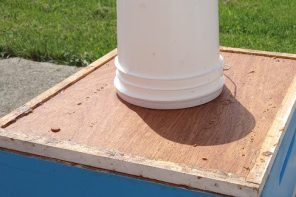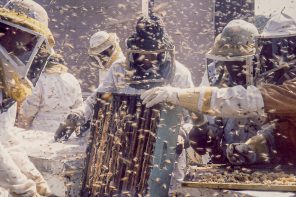Click Here if you listened. We’re trying to gauge interest so only one question is required; however, there is a spot for feedback!
Read along below!
Winter Insulation Revisited
With a Healthy Serving of Crow

By: Ross Conrad
The September 2022 issue of Bee Culture contained an article about Winter insulation where I theorized that the difference in insulation value of the wood making up a hollow tree and a standard Langstroth hive is not so significant that it would make much difference to a colony of bees overwintering inside. Then I read an article published in the August 2022 issue of the American Bee Journal written by Robin Radcliffe and Thomas Seeley titled, Thinking outside the box: Temperature dynamics in a tree cavity, wooden box and Langstroth hives with or without insulation. The article described the results of trials that measured temperature fluctuations inside various cavities observed between November 2019 and May 2021.
Radcliffe and Seeley compared the ambient outside temperature with the temperatures inside a living hollowed out maple tree, and a plain wooden box, both with cavities that matched in size and shape. They also looked at the temperature fluctuations in two Langstroth hives occupied by colonies of bees: one hive protected with a wool blanket that provided an insulation value of R-30 and the other without insulation. Ambient temperatures were taken inside of each hive studied as opposed to the temperatures inside the Winter cluster. The data collected during these trials showed that a cavity in a living tree insulated with 13 inches of wood on both sides, 20 inches in the back and six inches in the front was extremely stable, maintaining a temperature right around freezing during outside temperature fluctuations that ranged between 16°F and 36°F (-9°C to 2°C). The cavity that performed closest to the living tree during the trials was the occupied insulated hive that saw temperatures that ranged from about 39°F to 45°F (4°C to 7°C) during the same 24-hour period. Meanwhile, the temperature range in the uninsulated hive fluctuated between approximately 22°F to 54°F (-5.5°C to 12°C). What I failed to account for when I postulated that the insulation value of a hollow tree would not be much different from a standard Langstroth hive was the thermal mass of the cavity.
Thermal mass refers to the ability of a material to absorb and store heat which provides inertia against temperature fluctuations. For example, as the outside temperature fluctuates throughout the day, the large thermal mass of the concrete floor and walls located within the insulated portion of a house helps to flatten out the daily temperature swings, since the thermal mass absorbs heat when the temperature inside is warm, and releases its stored heat when the temperature drops. While complementary, thermal mass is different from insulation that prevents heat from entering or escaping.
All materials have thermal mass; however, the more dense a material, the greater its thermal mass potential. As a result, concrete and earth have a high thermal mass while air has very little. While wood is considered to have a relatively low thermal mass, relatively dense hardwood will have a slightly greater thermal mass than softwood, and a living tree is going to have a much higher thermal mass than the lumber that makes up a hive due to the moisture content of the wood. It is estimated that water stores three to four times as many BTU’s per pound as rock or masonry. Additionally, the fact that a living tree pulls up relatively warm moisture from deep beneath the ground is likely to further augment the heat storage capacity of a tree compared to a colony living in a dead tree or a hive made of kiln-dried milled lumber.

Comparisons of temperatures inside a pair of occupied Langstroth hives over a 24-hour period on November 17, 2019. One hive (yellow line) was outfitted with a wool hive blanket (Beehive Cozy Cover) and the other hive (green line) was not.
Thanks to the American Bee Journal for the use of this image.
The data collected during the Radcliffe and Seeley study clearly shows that the hives we provide our bees can be made to perform fairly similarly to a colony’s natural home (a hollow living tree) if the hive walls “are built with, or wrapped in, good insulation.” While I was wrong about the difference between the temperatures within a cavity inside a hollow tree compared to a standard hive, I believe the final conclusions of the September Bee Culture article (To Insulate, or not to Insulate) still stand. The fact that thousands of cold climate beekeepers have successfully overwintered bees in standard Langstroth-style hives without the use of insulation of any kind, indicates that the need to insulate colonies during Winter is of secondary importance except perhaps in the most extreme locations.
It is of primary importance for Winter survival to ensure bees are healthy, have plenty of honey and pollen and stay dry. I would amend my original article by acknowledging that in cases where colony health or food stores are marginal, the Radcliffe and Seeley trials suggest that insulation may mean the difference between survival and death.
It is typically believed that colonies of honey bees use the least amount of honey to maintain themselves when temperatures are at or about 40°F (4.5°C). If the amount of honey available to a wintering colony is a little shy, the ability of insulation to keep the internal temperature closer to this temperature sweet spot could allow a colony to survive on honey stores that would otherwise be insufficient without insulation surrounding the hive.
The same is true for a colony that has mite or pathogen issues that have not been adequately addressed by the beekeeper. When colonies are stressed by pest and disease pressure, the increased rate of honey bee population decline can adversely affect that ability of the cluster to maintain adequate temperatures within the brood area. The bees simply don’t have enough bodies to keep themselves warm. If the cavity they are occupying is insulated, such as in the hollow of a living tree, or a well insulated hive, then the moderation of temperature extremes provided by the insulation value of the cavity along with its thermal mass could mean the difference between life and death.
Decisions on apiary management need to be considered in a holistic manner and each beekeeper’s unique situation is going to affect which management decisions are going to be highly beneficial and which are not worth the time and effort. A backyard beekeeper with a few hives and who may not have the knowledge, time or resources to ensure colonies are entirely healthy and well stocked for Winter are likely to benefit from the addition of hive insulation. Meanwhile, those with a couple dozen hives or more are unlikely to want to take on the additional cost, work and required storage space to purchase, install and then during the Summer, store insulation for all their hives. Simply ensuring that good nutrition is plentiful, the bees are healthy and colonies stay dry will result in the desired outcome.
The reality is that all beekeeping is hyper-local and should be holistically based upon each beekeepers management style, goals, hive type, the strain of honey bee being managed and the local climate. This is the reason I am always weary of “Best Management Practices” which attempt to place all beekeepers into a one-size-fits-all mold.
Ross Conrad is the author of Natural Beekeeping: Revised and Expanded 2nd Edition and The Land of Milk and Honey: A history of beekeeping in Vermont.
Work cited:
Robin W. Radcliffe and Thomas D. Seeley (2022) Thinking Outside the Box: Temperature dynamics in a tree cavity, wooden box, and Langstroth hives with or without insulation, American Bee Journal, Vol. 162, No. 8: pp 893-898








